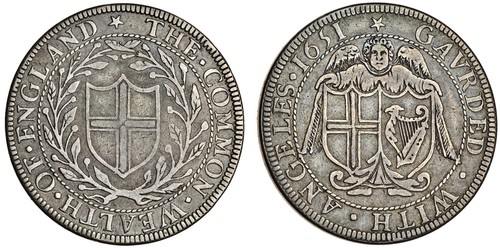
Auction: 15031 - The Slaney Collection of English Coins - Part 2
Lot: 364
Commonwealth, pattern Halfcrown, 15.23g, 1651, by Ramage, tooth border and rope inner circle both sides, i.m. mullet both sides, the. common. wealth. of. england, shield of England within laurel wreath, rev. gavrded . with . angeles . 1651; angel standing facing, holding the shields of England and Ireland, plain edge (ESC 445B -R7; N. - but 2734 listed as a Shilling), very fine, extremely rare
provenance
Lord Grantley, fifth portion, Glendining, 18-19 May 1944, lot 1880, 'well preserved and very rare', £42
T Bliss, Sotheby, 15-19 May 1916, lot 480, £7.10/-
J G Murdoch, second portion, Sotheby, 8-13 June 1903, lot 423, 'well preserved and unpublished, and exceedingly rare', £7
H Montagu, Sotheby, 13-20 November 1896, lot 709, 'very well preserved, unpublished', £9
S Addington, collection purchased en bloc by H Montagu in 1883
Ramage produced his pattern Halfcrowns and Sixpences on behalf of the Mint in response to the threat from the Frenchman Peter Blondeau. The Government had asked for patterns for four coins, for the gold coinage a 20-Shilling piece, and for the silver coinage a Halfcrown, a Shilling, and a Sixpence. Blondeau produced three patterns for the silver coins and Ramage produced this, for a Halfcrown, and a similar smaller piece for the Sixpence, but did not produce a pattern for the Shilling.
Pieces struck from the Ramage large, Halfcrown, die however, vary in weight, and also come with a lettered edge as well as a plain edge. Over the years many collectors have assumed that the pieces with plain edge were intended as Shillings. The problems with this interpretation however are that firstly the various weights are not exactly consistent with either denomination, and secondly since Ramage produced a perfectly good Sixpence size pattern, why did he not also produce a Shilling, as Blondeau did, instead of causing such confusion with the larger piece?
Bergne (Numismatic Chronicle vol. XVII, 1855), lists nine examples with lettered edge and eight with plain edge. He refers to those with lettered edge as Halfcrowns and to those with plain edge as Shillings, regardless of weight. North follows this, listing Halfcrowns with letttered edge, and Shillings 'thinner, and with plain or grained edge'. ESC lists all these as Halfcrowns.
To illustrate the continuing 'confusion,' the two Ramage pieces in the Norweb collection, Spink auction 56 (19 November 1986), lot 957 with lettered edge, 17.312g, and lot 959, plain edge, 6.123g, were catalogued as Halfcrown and Shilling respectively. It was noted that they were struck from the same dies. Fifteen years later the plain edge piece reappeared in Spink auction 154 (12 July 2001), this time catalogued as 'Pattern Halfcrown or Shilling'.
The present piece, at 15.23g, is clearly a Halfcrown, and cannot possibly be considered a Shilling. As this did not fit with the Bergne interpretation this piece was listed in both the Montagu and the Murdoch catalogues as an 'unpublished' Halfcrown. It is struck from the same dies as the Norweb pieces.
Question 113 of Thomas Aquinas' Summa Theologiae is, 'Are men guarded by angels?' Aquinas answers that they are, and he cites psalm 91.
The King James 1611 version gives us:
'There shall no evil befall thee: neither shall any plague come nigh thy dwelling.
For he shall give his Angels charge over thee: to keep thee in all thy ways.'
Subject to 20% VAT on Buyer’s Premium. For more information please view Terms and Conditions for Buyers.
Sold for
£16,000




